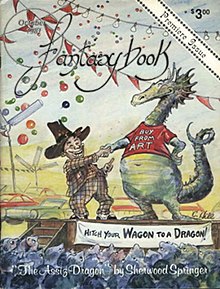
Asimov's Science Fiction is an American science fiction magazine published by Penny Press and edited by Sheila Williams. It was launched as a quarterly by Davis Publications in 1977, after obtaining Isaac Asimov's consent for the use of his name. It was originally titled Isaac Asimov's Science Fiction Magazine, and was quickly successful, reaching a circulation of over 100,000 within a year, and switching to monthly publication within a couple of years. George H. Scithers, the first editor, published many new writers who went on to be successful in the genre. Scithers favored traditional stories without sex or obscenity; along with frequent humorous stories this gave Asimov's a reputation for printing juvenile fiction, despite its success. Asimov was not part of the editorial team, but wrote editorials for the magazine.

Argosy was an American magazine. It was founded in 1882 as The Golden Argosy, a children's weekly, edited by Frank Munsey and published by E. G. Rideout. Munsey took over as publisher when Rideout went bankrupt in 1883, and after many struggles made the magazine profitable. He shortened the title to The Argosy in 1888 and targeted an audience of men and boys with adventure stories of all genres. In 1894 he switched it to a monthly schedule and in 1896 he eliminated all non-fiction and started using cheap pulp paper, making it the first pulp magazine. Circulation had reached half a million by 1907, and remained strong until the 1930s. The name was changed to Argosy All-Story Weekly in 1920 after the magazine merged with All-Story Weekly, another Munsey pulp, and from 1929 it became just Argosy.

Oriental Stories, later retitled The Magic Carpet Magazine, was an American pulp magazine published by Popular Fiction Co., and edited by Farnsworth Wright. It was launched in 1930 under the title Oriental Stories as a companion to Popular Fiction's Weird Tales, and carried stories with far eastern settings, including some fantasy. Contributors included Robert E. Howard, Frank Owen, and E. Hoffman Price. The magazine was not successful, and in 1932 publication was paused after the Summer issue.
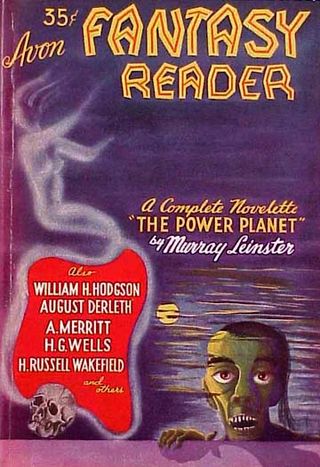
Avon published three related magazines in the late 1940s and early 1950s, titled Avon Fantasy Reader, Avon Science Fiction Reader, and Avon Science Fiction and Fantasy Reader. These were digest size magazines which reprinted science fiction and fantasy literature by now well-known authors. They were edited by Donald A. Wollheim and published by Avon.

Amazing Stories Annual was a pulp magazine which published a single issue in July 1927. It was edited by Hugo Gernsback, and featured the first publication of The Master Mind of Mars, by Edgar Rice Burroughs, which had been rejected by several other magazines, perhaps because the plot included a satire on religious fundamentalism. The other stories in Amazing Stories Annual were reprints, including two stories by A. Merritt, and one by H.G. Wells. The magazine sold out, and its success led Gernsback to launch Amazing Stories Quarterly the following year.

The Black Cat was an American fiction magazine launched in 1895 by Herman Umbstaetter, initially published in Boston, Massachusetts. It published only short stories, and had a reputation for originality and for encouraging new writers. Umbstaetter's editorial approach was unusual in several ways: the cover price was low, at five cents; he paid based on merit instead of story length; and he was willing to buy stories by new authors rather than insisting on well-known names. He frequently ran story contests to attract amateur writers. The magazine was immediately successful, and its circulation was boosted by the appearance in an early issue of "The Mysterious Card", by Cleveland Moffett, which was so popular that two print runs of the issue it appeared in sold out.

Flash Gordon Strange Adventure Magazine was a pulp magazine which was launched in December 1936. It was published by Harold Hersey, and was an attempt to cash in on the growing comics boom, and the popularity of the Flash Gordon comic strip in particular. The magazine contained a novel about Flash Gordon and three unrelated stories; there were also eight full-page color illustrations. The quality of both the artwork and the fiction was low, and the magazine only saw a single issue. It is now extremely rare.
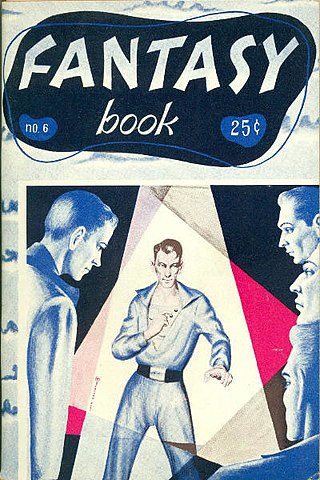
Fantasy Book was a semi-professional American science fiction magazine that published eight issues between 1947 and 1951. The editor was William Crawford, and the publisher was Crawford's Fantasy Publishing Company, Inc. Crawford had problems distributing the magazine, and his budget limited the quality of the paper he could afford and the artwork he was able to buy, but he attracted submissions from some well-known writers, including Isaac Asimov, Frederik Pohl, A. E. van Vogt, Robert Bloch, and L. Ron Hubbard. The best-known story to appear in the magazine was Cordwainer Smith's first sale, "Scanners Live in Vain", which was later included in the first Science Fiction Hall of Fame anthology, and is now regarded as one of Smith's finest works. Jack Gaughan, later an award-winning science fiction artist, made his first professional sale to Fantasy Book, for the cover illustrating Smith's story.

Ka-Zar was an American pulp magazine that published three issues in 1936 and 1937, edited by Martin Goodman. The lead character was modeled after Tarzan and the lead novel and short stories in each issue were adventures set in the jungle.

War Birds was a pulp magazine published by Dell from 1928 to 1937. It was the first pulp to focus on stories of war in the air, and soon had competitors. A series featuring fictional Irishman Terence X. O'Leary, which had started in other magazines, began to feature in War Birds in 1933, and in 1935 the magazine changed its name to Terence X. O'Leary's War Birds for three issues. In these issues the setting for stories about O'Leary changed from World War I to the near future; when the title changed back to War Birds later that year, the fiction reverted to ordinary aviation war stories for its last nine issues, including one final O'Leary story. The magazine's editors included Harry Steeger and Carson W. Mowre.

Mind Magic was an American pulp magazine which published six issues in 1931. The publisher was Shade Publishing Company of Philadelphia, and the editor was G.R. Bay. It focused on occult fantasy and non-fiction articles about occult topics. After four issues it changed its title to My Self, perhaps in order to broaden its appeal, but it ceased publication the following issue. Writers who appeared in its pages include Ralph Milne Farley, August Derleth, and Manly Wade Wellman.

Ace Mystery was a weird menace pulp magazine which published three issues starting in 1936, followed by two more under the title Detective Romances.

The Spider was an American pulp magazine that was published by Popular Publications from 1933 to 1943. Every issue included a lead novel that featured The Spider, a heroic crimefighter. The magazine was intended as a rival to Street & Smith's The Shadow and Standard Magazine's The Phantom Detective, which also featured crime-fighting heroes. The novels in the first two issues were written by R. T. M. Scott; thereafter every lead novel was credited to "Grant Stockbridge", a house name. Norvell Page, a prolific pulp author, wrote most of these; almost all the rest were written by Emile Tepperman and A. H. Bittner. The novel in the final issue was written by Prentice Winchell.
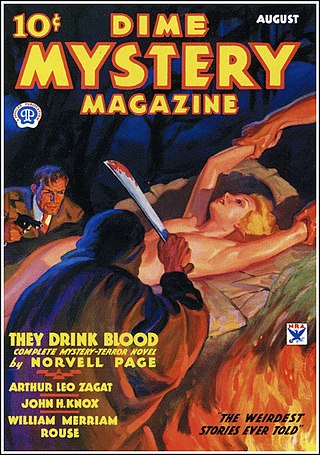
Dime Mystery Magazine was an American pulp magazine published from 1932 to 1950 by Popular Publications. Titled Dime Mystery Book Magazine during its first nine months, it contained ordinary mystery stories, including a full-length novel in each issue, but it was competing with Detective Novels Magazine and Detective Classics, two established magazines from a rival publisher, and failed to sell well. With the October 1933 issue the editorial policy changed, and it began publishing horror stories. Under the new policy, each story's protagonist had to struggle against something that appeared to be supernatural, but would eventually be revealed to have an everyday explanation. The new genre became known as "weird menace" fiction; the publisher, Harry Steeger, was inspired to create the new policy by the gory dramatizations he had seen at the Grand Guignol theater in Paris. Stories based on supernatural events were rare in Dime Mystery, but did occasionally appear.
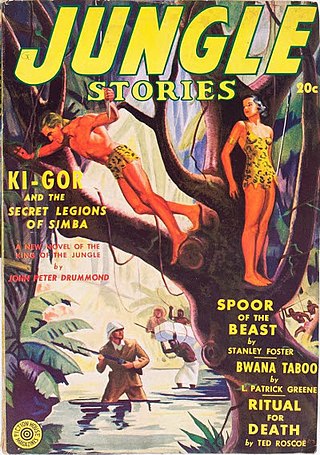
Jungle Stories was an American pulp magazine published from 1938 to 1954. The lead stories featured the adventures of Ki-Gor, the son of a Scottish missionary raised in the jungle like Tarzan. For the first two years, the novels formed a continuous narrative, including Ki-Gor meeting Helene Vaughan, a pilot who crashes in the jungle and is saved by Ki-Gor; they later marry. After 1940, the novels were unconnected episodes featuring both of them fighting perils that included some science fictional tropes such as talking gorillas and dinosaurs. The first novel was written by John M. Reynolds; all the later novels were listed under the house name "John Peter Drummond". Some of these were written by Stanley Mullen, but the authors of the others are unknown. Short stories appeared alongside the lead novel in each issue, from authors including Wilbur S. Peacock, Duane Rimel, Dan Cushman, Bryce Walton, and E. Hoffman Price.
The Western Raider was an American pulp magazine. The first issue was dated August/September 1938; it was followed by two more issues under that title, publishing Western fiction, and then was changed to a crime fiction pulp for two issues, titled The Octopus and The Scorpion. Both these two issues were named after a supervillain, rather than after a hero who fights crime, as was the case with most such magazines. Norvell Page wrote the lead novels for both the crime fiction issues; the second was rewritten by Ejler Jakobsson, one of the editors, to change the character from The Octopus to The Scorpion.
Thrilling Mystery was an American pulp magazine published from 1935 to 1944. New York publisher Standard Magazines had a stable of magazines with the "Thrilling" prefix, including Thrilling Detective, Thrilling Love, and Thrilling Adventures, but in 1935, Popular Publications, a rival publisher, launched a weird menace pulp titled Thrilling Mysteries. Standard Magazines sued over the use of the word "Thrilling", and Popular conceded, settling out of court. Thrilling Mysteries was cancelled after a single issue, and in October 1935 Standard began Thrilling Mystery. Like Thrilling Mysteries this was a terror pulp, but it contained less sex and violence than most of the genre, and as a result, in the opinion of science fiction historian Mike Ashley, "the stories had greater originality, although they are not necessarily of better quality". Ashley singles out Carl Jacobi's "Satan's Kite", about a family cursed because of a theft from a temple in Borneo, as worthy of mention. There were two detective stories by Robert E. Howard, the creator of Conan. Other contributors included Fritz Leiber, Fredric Brown, Seabury Quinn, Robert Bloch, and Henry Kuttner. There was little science fiction in the magazine, but some fantasy: pulp historian Robert K. Jones cites Arthur J. Burks "Devils in the Dust" as "one of the most effective" stories, with "a mood as bleak as an arctic blizzard", and Ashley agrees, calling it "particularly powerful".

Eerie Mysteries was an American weird menace pulp magazine that published four issues in 1938 and 1939. This was Ace Magazines' third weird menace pulp, and it was no more successful than its predecessors, Ace Mystery and Eerie Stories. As with Eerie Stories, the contents were all pseudonymous, and some were reprints from Ace Mystery or Ten Detective Aces, another Ace Magazines title, where the original detective story had enough violence to be a suitable candidate. The magazine's tagline was "10 Complete Horror-Thrillers", and the reprints had their titles changed to suit the new magazine, but the new titles, such as "When It Rained Corpses" by Ralph Powers, or "Skull and Double Cross-Bones" by Eric Lennon, stressed sex less than earlier weird menace magazines had done, and pulp historian Peter Haining cites Eerie Mysteries as an example of a magazine attempting to cash in on a trend that was already starting to fade away. Haining adds that the contents were also tamer than usual: "descriptions of beautiful females being molested and tortured were notably fewer". All four covers were painted by Norman Saunders, and Haining suggests that some or all of the interior art was re-used from other Ace Magazines titles.

Battle Birds was an American air-war pulp magazine, published by Popular Publications. It was launched at the end of 1932, but did not sell well, and in 1934 the publisher turned it into an air-war hero pulp titled Dusty Ayres and His Battle Birds. Robert Sidney Bowen, an established pulp writer, provided the lead novel each month, and also wrote the short stories that filled out the issue. Bowen's stories were set in the future, with the United States menaced by an Asian empire called the Black Invaders. The change was not successful enough to be extended beyond the initial plan of a year, and Bowen wrote a novel in which, unusually for pulp fiction, Dusty Ayres finally defeated the invaders, to end the series. The magazine ceased publication with the July/August 1935 issue. It restarted in 1940, under the original title, Battle Birds, and lasted for another four years. All the cover art was painted by Frederick Blakeslee.

Marvel Tales and Unusual Stories were two related American semi-professional science fiction magazines published in 1934 and 1935 by William L. Crawford. Crawford was a science fiction fan who believed that the pulp magazines of the time were too limited in what they would publish. In 1933, he distributed a flyer announcing Unusual Stories, and declaring that no taboos would prevent him from publishing worthwhile fiction. The flyer included a page from P. Schuyler Miller's "The Titan", which Miller had been unable to sell to the professional magazines because of its sexual content. A partial issue of Unusual Stories was distributed in early 1934, but Crawford then launched a new title, Marvel Tales, in May 1934. A total of five issues of Marvel Tales and three of Unusual Stories appeared over the next two years.
